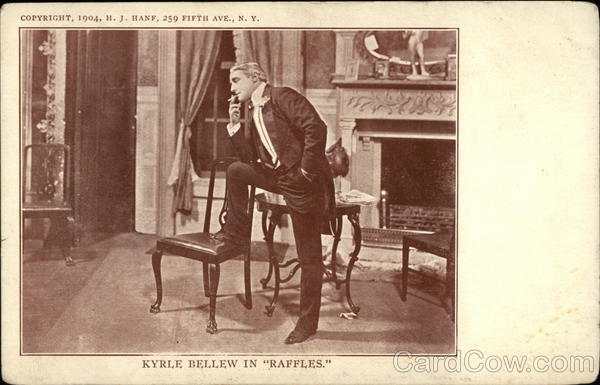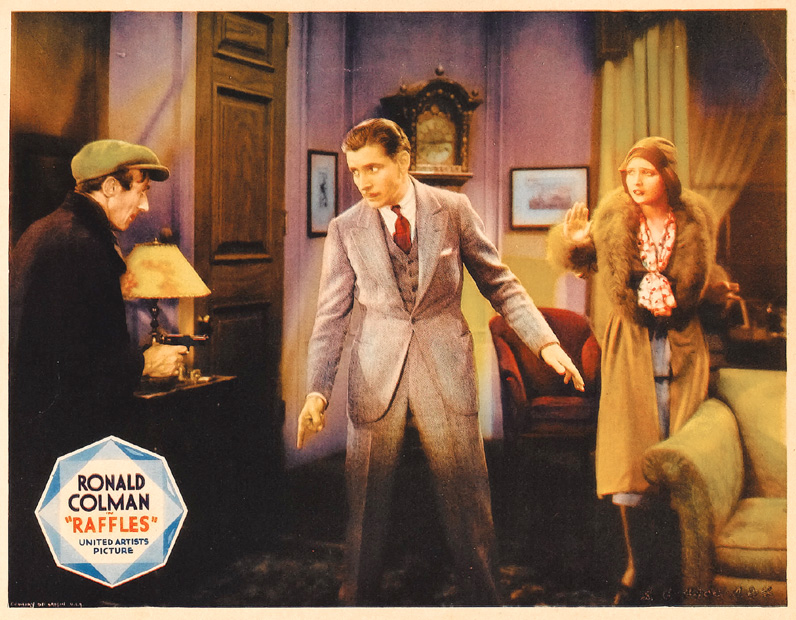The story of A. J. Raffles was first performed on Broadway as Raffles, The Amateur Cracksman on 27 October 1903 at the Princess Theatre. The play moved to the Savoy Theatre in February 1904 and closed out in March of that year racking up 168 performances. It starred Kyrle Bellew as Raffles, a young Clara Blandick as Gwendolyn and E. M. Holland as Captain Bedford. — Wikipedia
We have personally derived a great deal of pleasure from witnessing Mr. Eugene Presbrey's ingenious play of Raffles at the Princess Theatre, with Mr. Kyrle Bellew and Mr. E. M. Holland in the principal roles. Those who have read Mr. Hornung's two books, The Amateur Cracksman and Raffles, should by all means go to see the play; while those who have seen the play should not fail to read the books from which its material is largely drawn.
Mr. Presbrey's drama bears about the same relation to the Hornung stories as Mr. Gillette's Sherlock Holmes bears to Conan Doyle's original invention. In neither case does the play follow the books, but rather assimilates them and transmutes them into a dramatic form.
In one respect, Mr. Presbrey's play is more effective than Mr. Gillette's; for it reserves its grand climax—a most startling and unexpected one—for the final curtain, whereas in Sherlock Holmes the real climax is the episode of the gas chamber. After that, the rest of the play is comparatively tame. On the other hand, there is nothing so original and creepy in Raffles as this same gas chamber, and the cleverness of Raffles himself has not the superb assurance with which Mr. Gillette so perfectly panoplies his impersonation of Holmes.
Moreover, it jars upon one's sense of the probable to see Raffles in his early fencing with the detective doing everything which in life would draw suspicion upon himself. His continual and suspicious allusions to the Cracksman, his bet with Bedford, and his obvious self-consciousness all through the first act, are neither necessary nor artistic. Mr. Bellew ought to take a lesson here from Mr. Gillette and cultivate a little more self-repression besides cutting some of his lines and modifying some of his business.
When the detective, Bedford, says that he hopes soon to meet the Cracksman face to face, and Raffles replies, "And so do I!" (or words to that effect), it is surely absurd for him to thrust his face forward so as almost to touch his adversary's. Even a Scotland Yard detective—a Lestrade or a Gregson—would have suspected him after that.
Mr. E. M. Holland is delightful as Captain Bedford, repeating both his make-up and his success of twenty years ago as the detective in Jim the Penman. His face is a study at every moment, and his conception of a Dundreary in the role of a criminal expert is inimitably comic. For genuine entertainment, this is one of the very best plays of the season.
The Raffles of Mr. Hornung's books (which are published by the Messrs. Scribner) differs in some respects from the Raffles of the play. The latter is made to appear a genuine amateur in crime and to rob only for the excitement of the thing. This, of course, is to make it easier for the audience to sympathise with him. In the book, he plunders because he is hard up and needs the money.
So, too, with Bunny, who in the play has no share in the misdeeds of Raffles, but who in the book becomes a burglar of his own choice and finally gets a term in prison.
Someone suggested several years ago that Mr. Hornung and Conan Doyle should write a book in collaboration, pitting the clever criminal, Raffles, against the inspired detective, Holmes. But apart from the impossibility of that kind of collaboration (for both authors would have to agree as to which hero should ultimately win), Raffles is not in the same class as Sherlock Holmes. He is several times outwitted in the stories—once by the South African millionaire and again by Captain Mackenzie, a mere Scotchman. In fact, as a criminal he is about on a level with the originator of the Red Headed League. The man who patiently wove a net around Professor Robert Moriarty would have run down Raffles in twenty-four hours. — "Chronicle and Commentary: Raffles," THE BOOKMAN (January 1904)It wasn't long before an American copycat would appear:
Figuratively speaking, Raffles was originally a Londoner, with chambers at the Albany and a very wide and respectable speaking acquaintance in his favourite thoroughfares of Pall Mall and Bond Street.
Then, metamorphosised into the person of M. Leblanc's Arsene Lupin, he crossed the channel to France, and became a typical Parisian flaneur who could be found of a sunshiny afternoon taking his aperitif at one of the little tin tables in front of the Cafe de la Paix.
Now, in a third incarnation, he reappears on Broadway as Mr. "Frisco" Jackson, the hero of a recent narrative by Mrs. Helen Green. Taking it all in all, we should say that there is rather more basic moral honesty in Mr. Jackson than either his English or French predecessor.
There is nothing ambiguous about his profession, or his attitude toward society. He is just a plain confidence man of the type to be found at Broadway and Forty-second Street, New York. But underlying his rascality there are points of chivalry and forbearance which enlist the sympathy, and with each new incident the reader comes more and more to regard him in the light of a knight errant going down to joust in very sordid lists.
Then again, this Broadway Raffles has known and been influenced by O. Henry's Mr. Jefferson Peters. — "Chronicle and Comment: Raffles on Broadway," THE BOOKMAN (December 1909)
. . . though Sherlock Holmes would forever remain the most popular fictional character, Raffles would rapidly become the second most popular fictional character of the time. — Richard Bleiler, "Raffles: The Gentleman Thief," STRAND MAGAZINEResources:
- A RAP SHEET review of Raffles's original adventures is HERE.
- The most popular film adaptation of the original play is the Ronald Colman version described HERE.
Category: Detective fiction


No comments:
Post a Comment